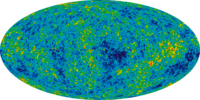
Photo from wikipedia
We explore the effect of neutron lifetime and its uncertainty on standard big bang nucleosynthesis (BBN). BBN describes the cosmic production of the light nuclides, 1H, D, 3H+3He, 4He, and… Click to show full abstract
We explore the effect of neutron lifetime and its uncertainty on standard big bang nucleosynthesis (BBN). BBN describes the cosmic production of the light nuclides, 1H, D, 3H+3He, 4He, and 7Li+7Be, in the first minutes of cosmic time. The neutron mean life τn has two roles in modern BBN calculations: (1) it normalizes the matrix element for weak n↔p interconversions, and (2) it sets the rate of free neutron decay after the weak interactions freeze-out. We review the history of the interplay between τn measurements and BBN, and present a study of the sensitivity of the light element abundances to the modern neutron lifetime measurements. We find that τn uncertainties dominate the predicted 4He error budget, but these theory errors remain smaller than the uncertainties in 4He observations, even with the dispersion in recent neutron lifetime measurements. For the other light element predictions, τn contributes negligibly to their error budget. Turning the problem around, we combine present BBN and cosmic microwave background (CMB) determinations of the cosmic baryon density to predict a “cosmologically preferred” mean life of τn(BBN+CMB)=870±16s, which is consistent with experimental mean life determinations. We show that if future astronomical and cosmological helium observations can reach an uncertainty of σobs(Yp)=0.001 in the 4He mass fraction Yp, this could begin to discriminate between the mean life determinations.
Journal Title: Universe
Year Published: 2023
Link to full text (if available)
Share on Social Media: Sign Up to like & get
recommendations!